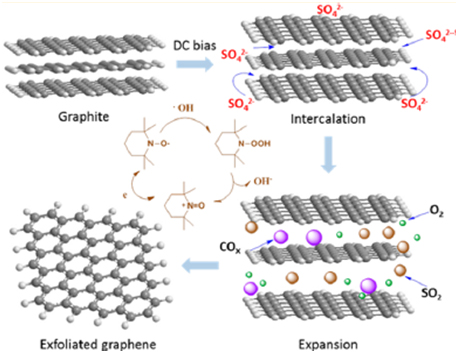
Abstract
Despite the intensive research efforts devoted to grapheme fabrication over the past decade, the production of high-quality graphene on a large scale, at an affordable cost, and in a reproducible manner still represents a great challenge. Here, we report a novel method based on the controlled electrochemical exfoliation of graphite in aqueous ammonium sulfate electrolyte to produce graphene in large quantities and with outstanding quality. Because the radicals (e.g., HO•) generated from water electrolysis are responsible for defect formation on graphene during electrochemical exfoliation, a series of reducing agents as additives (e.g., (2,2,6,6-tetramethylpiperidin-1-yl)oxyl (TEMPO), ascorbic acid, and sodium borohydride) have been investigated to eliminate these radicals and thus control the exfoliation process. Remarkably, TEMPO-assisted exfoliation results in large graphene sheets (5−10 μm on average), which exhibit outstanding hole mobilities (∼405 cm2 V−1 s−1), very low Raman ID/IG ratios (below 0.1), and extremely high carbon to oxygen (C/O) ratios (∼25.3). Moreover, the graphene ink prepared in dimethylformamide can exhibit concentrations as high as 6 mg mL−1, thus qualifying this material for intriguing applications such as transparent conductive films and flexible supercapacitors. In general, this robust method for electrochemical exfoliation of graphite offers great promise for the preparation of graphene that can be utilized in industrial applications to create integrated nanocomposites, conductive or mechanical additives, as well as energy storage and conversion devices.